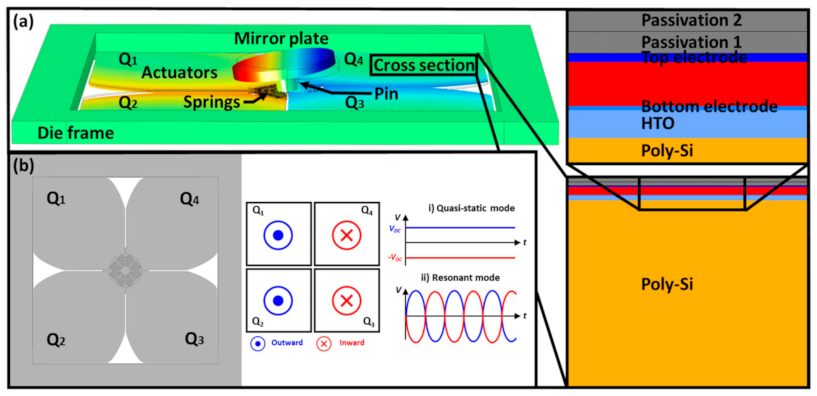Development of Piezoelectrically Driven Quasi-Static 2D MEMS Mirrors with Extremely Large FoV for Scanning LiDARs †
Abstract
:1. Working Principle of a MEMS Scanner
2. Design Optimization
2.1. Thickness
2.2. Actuators and Springs
2.3. Outlook
Author Contributions
Funding
Institutional Review Board Statement
Informed Consent Statement
Data Availability Statement
Conflicts of Interest
References
- Gu-Stoppel, S.; Lisec, T.; Fichtner, S.; Funck, N.; Eisermann, C.; Lofink, F.; Wagner, B.; Müller-Groeling, A. A highly linear piezoelectric quasi-static MEMS mirror with mechanical tilt angles of larger than 10°. In Proceedings of the MOEMS and Miniaturized Systems XVIII, San Francisco, CA, USA, 2–4 February 2019; p. 1093102. [Google Scholar]
- Gu-Stoppel, S.; Lisec, T.; Claus, M.; Funck, N.; Fichtner, S.; Schröder, S.; Wagner, B.; Lofink, F. A triple-wafer-bonded AlScN driven quasi-static MEMS mirror with high linearity and large tilt angles. In Proceedings of the MOEMS and Miniaturized Systems XIX, San Francisco, CA, USA, 1–3 February 2020; p. 1129304. [Google Scholar]
- Sun, C.; Liu, Y.; Li, B.; Su, W.; Luo, M.; Du, G.; Wu, Y. Modeling and Optimization of a Novel ScAlN-Based MEMS Scanning Mirror with Large Static and Dynamic Two-Axis Tilting Angles. Sensors 2021, 21, 5513. [Google Scholar] [CrossRef] [PubMed]

Disclaimer/Publisher’s Note: The statements, opinions and data contained in all publications are solely those of the individual author(s) and contributor(s) and not of MDPI and/or the editor(s). MDPI and/or the editor(s) disclaim responsibility for any injury to people or property resulting from any ideas, methods, instructions or products referred to in the content. |
© 2024 by the authors. Licensee MDPI, Basel, Switzerland. This article is an open access article distributed under the terms and conditions of the Creative Commons Attribution (CC BY) license (https://creativecommons.org/licenses/by/4.0/).
Share and Cite
Raschdorf, P.; Hwang, J.-Y.; Wysocki, L.; Wen, L.; Albers, J.; Wille, G.; Yarar, E.; Gu-Stoppel, S. Development of Piezoelectrically Driven Quasi-Static 2D MEMS Mirrors with Extremely Large FoV for Scanning LiDARs. Proceedings 2024, 97, 124. https://doi.org/10.3390/proceedings2024097124
Raschdorf P, Hwang J-Y, Wysocki L, Wen L, Albers J, Wille G, Yarar E, Gu-Stoppel S. Development of Piezoelectrically Driven Quasi-Static 2D MEMS Mirrors with Extremely Large FoV for Scanning LiDARs. Proceedings. 2024; 97(1):124. https://doi.org/10.3390/proceedings2024097124
Chicago/Turabian StyleRaschdorf, Paul, Jeong-Yeon Hwang, Lena Wysocki, Lianzhi Wen, Jörg Albers, Gunnar Wille, Erdem Yarar, and Shanshan Gu-Stoppel. 2024. "Development of Piezoelectrically Driven Quasi-Static 2D MEMS Mirrors with Extremely Large FoV for Scanning LiDARs" Proceedings 97, no. 1: 124. https://doi.org/10.3390/proceedings2024097124





